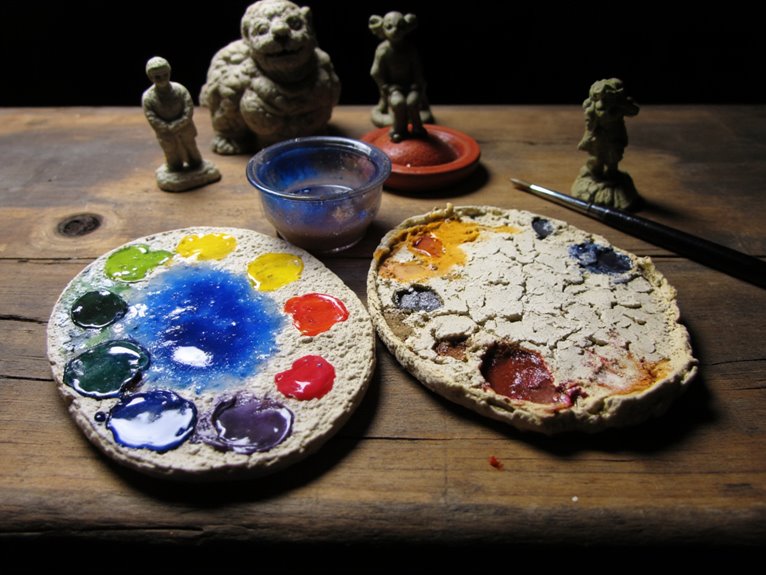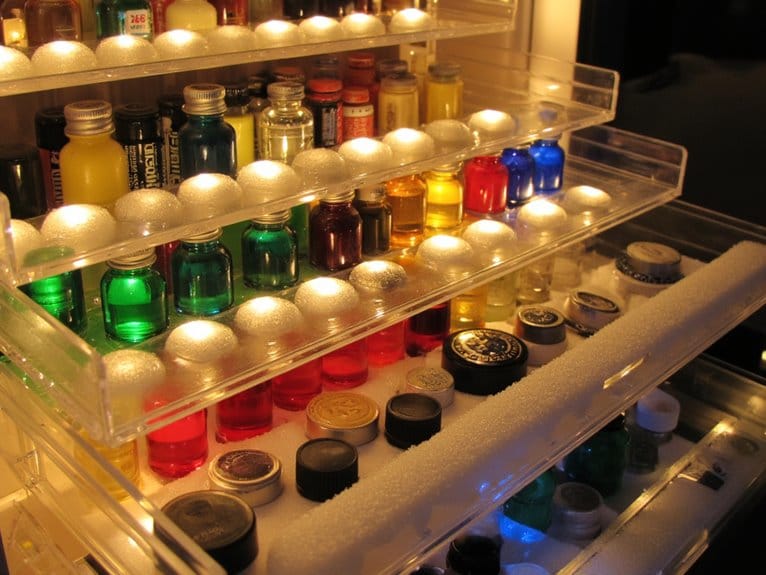We are supported by our audience. When you purchase through links on our site, we may earn an affiliate commission, at no extra cost for you. Learn more. Last update on 1st July 2025 / Images from Amazon Product Advertising API.
You’ll find wet palettes keep acrylic paints workable for days while reducing waste by 60-80%, making them ideal for complex blending and layering techniques. Dry palettes offer immediate setup and faster decision-making, perfect for speed painting and base coating multiple miniatures. Wet systems require more maintenance and workspace but excel in hot conditions, whereas dry palettes encourage quick color choices and precise paint consistency control. Your painting style and session length determine which approach maximizes your efficiency and results.
Notable Insights
- Wet palettes keep paints workable for days/weeks and reduce waste by 60-80%, while dry palettes require immediate use within 15-30 minutes.
- Dry palettes offer instant setup and encourage quick decision-making, ideal for speed painting and assembly-line techniques across multiple miniatures.
- Wet palettes excel at complex blending and layering techniques, providing extended time for precise color transitions and detailed work.
- Dry palettes are lightweight, portable, and require minimal workspace with no risk of water spills or moisture maintenance.
- Wet palettes need ongoing maintenance including misting, sponge replacement, and mold prevention, while dry palettes have minimal upkeep requirements.
Understanding Palette Types and Core Functionality
When you’re choosing between wet and dry palettes for miniature painting, understanding their fundamental designs reveals why each serves distinct purposes in your workflow.
Wet palettes feature three essential components: an airtight container, moisture-retentive sponge, and specialized palette paper. This palette comparison shows wet systems maintain humidity by creating an enclosed environment that slows paint evaporation. Your paints stay workable for hours or days when properly sealed.
Dry palettes operate on simplified principles without moisture retention mechanisms. They provide direct control over paint consistency but require prompt use after mixing. Dry palettes offer easy cleanup since you simply discard the paper after each painting session.
The sponges in wet palettes often include dual textures like nylon sides for ideal moisture control. Palette paper stays slightly dampened to keep paints thin—crucial for layering techniques.
Dry systems excel when you need controlled moisture levels for specific blending methods like Two Brush Blending. However, paint won’t remain usable indefinitely even in a sealed wet palette environment due to natural degradation over time. Wet palette systems can reduce paint waste by 60-80% compared to traditional dry palette methods.
Benefits of Using Dry Palettes for Miniatures
You’ll find dry palettes offer distinct advantages when speed and precision matter most in your miniature painting workflow.
Your setup time drops to seconds since you simply squeeze paint directly onto the surface without preparing moisture systems or arranging parchment paper.
This streamlined approach forces you to work decisively with your color choices, eliminating the hesitation that often slows down painting sessions while giving you complete control over paint consistency throughout your work. The predictable paint behavior ensures consistent results since there’s no palette moisture affecting how your colors mix or flow.
The slower drying time of dry palettes proves particularly advantageous for advanced techniques like 2BB, where maintaining optimal paint viscosity throughout the application process is crucial for achieving professional results.
Professional painters often prefer high-quality acrylic paints with their self-leveling properties, which perform exceptionally well on dry palettes where consistent paint behavior matters most.
Speed and Control
Although wet palettes dominate many miniature painting discussions, dry palettes offer distinct advantages for speed and control that shouldn’t be overlooked. Fast-drying paint forces quicker decision making and prevents overthinking during sessions. You’ll develop more decisive brush techniques as rapid evaporation compels efficient application.
Direct paint application eliminates moisture variables that affect consistency. You won’t need water adjustments, maintaining predictable paint behavior on your miniatures. This removes dilution risks and simplifies thickness control for layering work.
Clean surfaces start fresh each session, avoiding contamination from old paint. No moisture buildup means fewer debris issues affecting quality. Using small quantities of paint on dry palettes maximizes efficiency since miniature painting requires minimal amounts per application.
The streamlined workflow requires less setup time, letting you focus on actual painting rather than palette maintenance. Using large brushes with dry palettes can significantly accelerate your painting process by covering more surface area efficiently.
Simplified Setup Benefits
Three key advantages make dry palettes exceptionally practical for miniature painters: minimal preparation requirements, instant availability, and zero maintenance overhead. Your palette preparation involves simply placing paint directly onto the surface—no water layers, membranes, or humidity management required.
This streamlined approach eliminates the complex setup procedures that wet palettes demand.
The user experience becomes significantly more efficient when you’re ready to paint immediately. Coated paper pads offer disposable convenience, while plastic and ceramic surfaces provide reusable alternatives.
You’ll spend less time on preparation and cleanup, focusing energy on actual painting instead. Paint rejuvenation requires only small water amounts when needed.
Transportation becomes effortless without water spillage concerns or sealing mechanisms, making dry palettes ideal for conventions and mobile painting sessions. Additionally, you won’t face any mold issues that can develop with moisture-retaining wet palette systems.
Advantages of Wet Palette Systems
Wet palette systems transform miniature painting through superior paint preservation and extended working time. You’ll maintain paint workability for days or weeks instead of minutes. The hydration membrane prevents acrylic drying while preserving original consistency and viscosity.
| Benefit | Wet Palette | Dry Palette |
|---|---|---|
| Paint lifespan | Days to weeks | 15-30 minutes |
| Color mixing | Extended blending time | Rapid drying limits work |
| Cost efficiency | Minimal waste | High paint loss |
| Session flexibility | Pause/resume anytime | Continuous work required |
| Climate performance | Consistent in heat/dry conditions | Poor in warm environments |
You’ll achieve superior color mixing with smooth gradients and seamless shifts. Paint preservation eliminates constant re-mixing of custom colors. The moist surface supports advanced techniques like layering and shading that require extended open times for precise application. For consistently mixed paints, vortex mixers can blend your acrylics and metallics thoroughly in just 3-15 seconds before transferring to your wet palette.
Best Applications and Use Cases for Each Type

You’ll find that your choice between wet and dry palettes often depends on your specific painting goals and time constraints.
Speed painting scenarios typically favor dry palettes because you can load paint quickly, apply it immediately, and move between colors without worrying about extended working times or complex setup procedures.
Complex blending projects, however, demand the extended working time that wet palettes provide, allowing you to manipulate paint changes over several minutes rather than racing against rapid drying times.
Speed Painting Scenarios
When speed becomes your primary painting objective, choosing between wet and dry palettes fundamentally changes your workflow dynamics and achievable results. Dry palettes excel in assembly-line painting where you’re applying base coats rapidly across multiple miniatures. The fast drying times force immediate application, creating natural rhythm and eliminating palette maintenance concerns.
| Palette Type | Setup Time | Working Time | Best For |
|---|---|---|---|
| Dry | Immediate | 2-5 minutes | Base coating, blocking |
| Wet | 2-3 minutes | 15-30 minutes | Blending, mixing |
| Dry | Zero maintenance | Paint dries fast | Batch painting |
| Wet | Regular cleaning | Extended sessions | Detail work |
Wet palettes support controlled speed blending when your workflow includes shifting techniques. They prevent paint waste during brief pauses while maintaining workable consistency for detailed applications.
Complex Blending Projects
Complex blending projects demand extended working times and precise moisture control that fundamentally separates wet and dry palette applications.
You’ll need wet palettes for gradual color shifts spanning multiple painting sessions. The moisture maintains paint consistency for several hours, preventing waste during intricate blends. Your paints stay workable longer, supporting multistage mixing without intermediate colors hardening.
However, dry palettes excel when you require controlled drying times for specific blending techniques. Two Brush Blending demands partially dried paint layers to achieve smooth shifts without streaking. You can manipulate paint flow precisely on dry surfaces, preventing unintended dilution that compromises color integrity.
Choose wet palettes for extended gradient work and complex layering sequences. Select dry palettes when your blending techniques require deliberate paint drying control and precise timing.
Common Limitations and Challenges
While wet and dry palettes each offer distinct advantages for miniature painting, both systems present specific limitations that can impact your painting workflow and final results.
Wet palette issues include evaporation-related moisture loss requiring regular misting, potential mold growth from extended closure periods, and paint mixing challenges caused by gradual dilution over time.
You’ll face limited workspace on smaller wet palette surfaces and ongoing maintenance demands including frequent sponge replacement.
Dry palette drawbacks center on accelerated paint drying that reduces blending time and increases waste potential.
You’ll encounter consistency concerns as paint hardens faster on surfaces, creating uneven application risks. Surface material variations affect paint flow characteristics differently.
Both systems require balancing moisture levels—wet palettes need excess water management while dry palettes demand premature drying prevention through manual thinning techniques.
Speed Painting Considerations
Beyond these operational constraints, palette choice greatly impacts your painting speed and workflow efficiency during miniature projects.
Dry palettes force rapid execution since paint dries within minutes, requiring complete color selection and technique planning before you start. This urgency builds muscle memory and eliminates overthinking. You’ll develop faster brush movements and accept imperfections rather than pursuing gradual perfection.
Conversely, wet palettes extend working time but may slow your overall pace. The moisture retention allows mid-session adjustments yet can tempt over-working areas.
Palette maintenance differs greatly between types. Dry palettes need zero prep time, letting you begin immediately.
Wet palettes require setup with water and membrane, plus ongoing moisture monitoring. For speed painting challenges, dry palettes create productive pressure that enhances focus and decision-making speed.
Workspace and Portability Factors
Your workspace dimensions and mobility requirements greatly influence which palette type suits your miniature painting setup.
Dry palettes demand minimal space with their simple flat surfaces. You can place them anywhere without water spillage concerns.
Wet palettes require more room for their container, sponge, and parchment assembly, plus careful positioning to prevent leaks.
Transport challenges differ markedly between types.
Dry palettes offer lightweight portability and rapid setup.
Wet palettes contain water layers, making them bulkier and requiring secure sealing during transport. Temperature changes affect wet palette moisture levels, potentially altering paint consistency.
For workspace organization, dry palettes provide straightforward operation with minimal preparation.
Wet palettes involve component assembly, increasing setup complexity but offering superior paint freshness control through controlled humidity.
Choosing the Right Palette for Your Painting Style
How you paint miniatures determines which palette type delivers ideal results for your specific techniques and workflow. Your approach to color theory and blending requirements directly influences palette selection.
Your painting style and workflow should drive palette selection, not the other way around.
- Speed painting techniques benefit from dry palettes that encourage rapid brushwork and prevent overthinking color mixing decisions.
- Layered painting styles require wet palettes to maintain paint longevity during extended blending sessions and gradual color shifts.
- Two Brush Blending (2BB) works best with dry palettes that provide controlled paint moisture levels and faster drying times.
- Complex color theory applications favor wet palettes that keep multiple paint mixtures workable simultaneously for sophisticated color relationships.
Fast painters need dry palettes to maintain momentum. Detail-oriented artists require wet palettes for extended working time.
Match your palette choice to your natural painting rhythm and preferred techniques.
On a final note
You’ll find success with either palette type once you match it to your specific painting requirements. Dry palettes excel for speed painting sessions and portable setups where you’re mixing small amounts quickly. Wet palettes dominate extended painting sessions where paint consistency and working time matter most. Your choice depends on project duration, workspace constraints, and painting techniques. Test both systems with your current miniature projects to determine which delivers better results for your specific workflow and style preferences.

